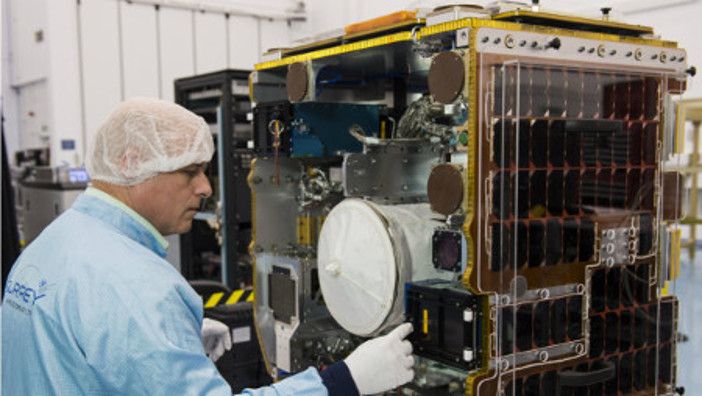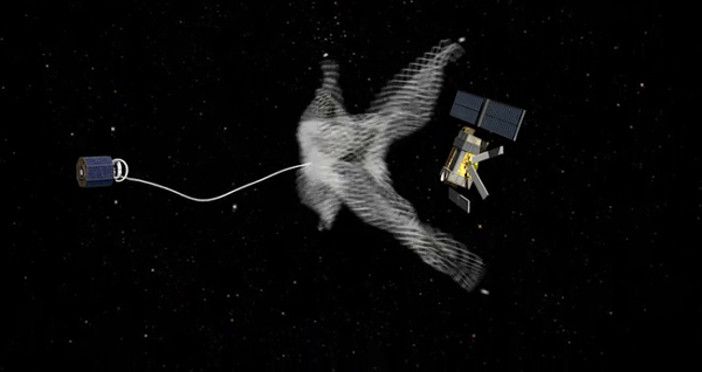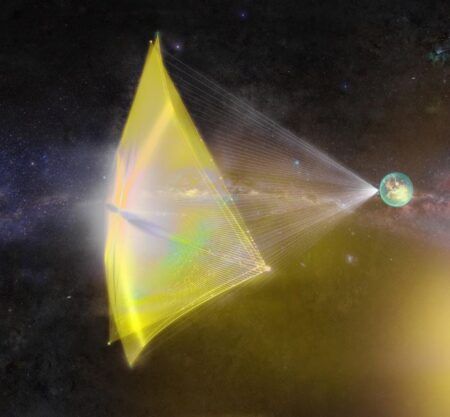The European RemoveDebris project will trial the use of a harpoon and net to collect old space debris such as defunct spacecraft, abandoned launch vehicle stages, and mission-related and fragmentation debris.
The project aims to solve what has been recognized internationally as a growing problem. As we send more satellites into space the number of old, inactive ones in orbit is increasing.
According to the US Space Surveillance Network there are 40,000 defunct objects, more than 7,600 tonnes of space junk, in and around Earth’s orbit. Some are moving as fast as 30,000mph.
The chances of a collision are steadily increasing. Professor Guglielmo Aglietti, director of the Surrey Space Centre at the University of Surrey in the UK and research lead for the Remove Debris project, says, “It’s important to remember that a few significant collisions have already happened. Therefore, to maintain the safety of current and future space assets, the issue of the control and reduction of the space debris has to be addressed.
Launch window
The €15m (US$17.5m) RemoveDebris project started at the end of 2013. The spacecraft and its payloads were extensively ground tested for the last two years. RemoveDebris was then launched on April 2 from the Kennedy Space Center in Florida on a SpaceX Falcon 9 rocket and was successfully delivered to the International Space Station (ISS).
During this month (June?) the satellite will be released by an astronaut, who will remove the satellite’s protective panels and place it in the airlock for it to be deployed, via the NanoRacks Kaber system, a reusable device that provides command and control for satellite deployments from the ISS.
Once it is a safe distance from the ISS, the spacecraft will eject two cubesats. There will then be four technology demonstrations over a period of up to eight months. Each demo will take about a week to perform, followed by two weeks to download the data. The gaps between the demonstrations are to wait for the targets to arrive near the satellite.
In the first of two capture experiments, a net will be discharged by the spacecraft at one of the deployed target cubesats to demonstrate net capture in space. The second capture experiment will see a harpoon launched at a deployable target plate, made of representative satellite panel materials – the first harpoon capture in orbit.
The third experiment involves vision-based navigation by deploying the second cubesat and demonstrating rendezvous navigation using cameras and a lidar.
Finally, the RemoveDebris spacecraft will deploy a large dragsail to cause de-orbit, where it will burn up as it enters Earth’s atmosphere.

Design and test
Speaking at the Defence Space Conference last week in London, Aglietti discussed the project’s development: “The design drivers were similar to a regular satellite. We had to provide proper support for the payload and a level of autonomy for when there is no visibility form the ground station.
“There were also the typical challenges and administrative issues, such as obtaining a space license. This is the first satellite to be released from the space station in this size range of about 100kg, so there were a lot of safety reviews and authorizations to get.”
Surrey Space Centre assembled the satellites for the mission. The harpoon target assembly was developed by Airbus UK and the deployable system by Oxford Space Systems. “There were extensive tests conducted – shooting the harpoon at the inflatable debris target,” Aglietti added.
Once the net hits the target, a series of counterweights with enclosed motors wraps around the target and reels it in to encapsulate it. Functional testing of the net deployment was conducted on both a Novespace A300 parabolic flight and within the Fallturm Drop Tower at the University of Bremen, Germany. Good performance was demonstrated both in simulation and in functional testing.
The tests conducted on the harpoon focused on how to protect the boom of the satellite from the impact energy caused by the harpoon striking the target. This was done using flexible couplings. Functional testing determined an optimum pin design and successfully demonstrated a combination of flexible couplings and a Dyneema tether.
The test campaign covered all of the payloads and the platform to demonstrate the functional viability of the experiments and that the experiments can survive the space environment. Space environmental tests conducted included vibration, thermal, vacuum and thermal-vacuum tests, as well as electromagnetic compatibility and shock. The test flow differed for each payload and depended on the heritage of the constituent payload parts.
Aurélien Pisseloup, space engineer at Airbus, a partner company on the project, said, “Contributing to this exciting mission with our expertise and concretely with our harpoon, net experiments and vision-based navigation moves the international space community one big step forward in tackling space debris.”
More information on RemoveDebris’ testing can be found here.





